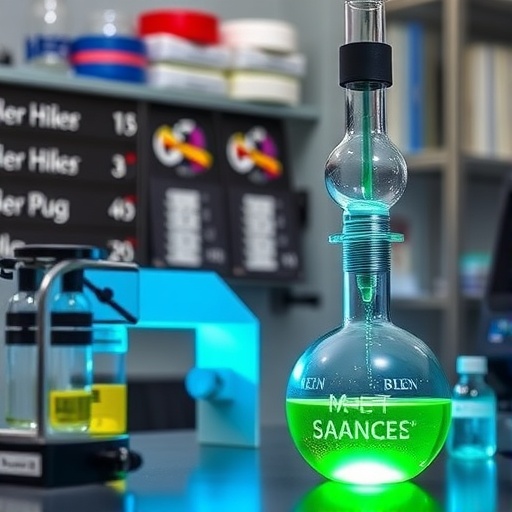
Milan, 31 July 2025 – In a groundbreaking advancement that could revolutionize sustainable chemical manufacturing, researchers at the Politecnico di Milano have unveiled a pioneering single-atom catalyst exhibiting unprecedented adaptive chemical behavior. This novel catalyst can intelligently and reversibly modulate its catalytic activity in response to its surrounding chemical environment. This development represents a paradigm shift in catalyst design, providing a blueprint for creating more energy-efficient, selective, and environmentally friendly industrial chemical processes.
Published recently in the highly respected Journal of the American Chemical Society, this study details the first-ever demonstration of a catalyst material capable of switching between distinct chemical functionalities at the atomic level. By harnessing a ‘molecular switch’ mechanism, the catalyst toggles between two pivotal organic reactions — borylation and carbon-carbon (C-C) coupling. The ability to dynamically switch catalytic pathways holds significant promise for streamlining multi-step synthetic sequences typically reliant on separate catalysts and conditions, thus reducing waste and energy consumption.
At the core of this breakthrough is a palladium-based single-atom catalyst. The catalyst’s atomic palladium centers are intricately embedded within a bespoke organic scaffold designed to confer exceptional stability and precise control over the metal’s electronic environment. This unique architecture enables the catalyst to respond chemically to varying reaction parameters such as temperature, solvent polarity, or reactant composition. Such responsiveness allows selective engagement with either bioreaction pathways or C–C coupling mechanisms, two reactions fundamental to organic synthesis with broad applications in pharmaceuticals, agrochemicals, and material science.
.adsslot_68FcklZTa9{width:728px !important;height:90px !important;}
@media(max-width:1199px){ .adsslot_68FcklZTa9{width:468px !important;height:60px !important;}
}
@media(max-width:767px){ .adsslot_68FcklZTa9{width:320px !important;height:50px !important;}
}
ADVERTISEMENT
The design rationale pivots on molecular-level control that mimics biological enzymes’ adaptability but with enhanced programmability and robustness. By tailoring the ligand environment around the palladium atom, the research team effectively created a switchable active site whose electronic properties—and consequently, reactivity—can be modulated on demand. This intelligent catalyst exhibits a level of versatility and selectivity previously unattainable with traditional heterogeneous or homogeneous catalysts, which are often locked into a static mode of operation.
Professor Gianvito Vilé, the lead investigator and a lecturer at the ‘Giulio Natta’ Department of Chemistry, Materials and Chemical Engineering at Politecnico di Milano, emphasizes the transformative potential of this adaptive catalyst. “We have engineered a chemical system capable of modulating its reactivity in a controlled and reversible manner, instilling intelligence into catalysis,” Vilé explains. “This work opens pathways to more sustainable chemical processes that minimize environmental impact while maximizing efficiency.”
In addition to the catalyst’s reaction-switching capability, the research highlights its impressive stability and recyclability. The single-atom framework resists aggregation or degradation over multiple catalytic cycles, ensuring consistent performance. Moreover, life cycle and ‘green chemistry’ assessments conducted alongside the experimental work demonstrate significant reductions in hazardous waste, toxic reagent usage, and energy input compared to conventional catalytic systems. This aligns with global efforts to transition toward greener industrial chemistries.
The catalyst’s efficacy was validated through a series of rigorous experimental protocols, including spectroscopic characterization, kinetic analyses, and reaction optimization studies. These methods confirmed that subtle changes in reaction conditions prompted well-defined shifts in catalytic pathways, affirming the precise tunability of the atomic active sites. Such fine control will allow chemists to design bespoke synthetic routes tailored exactly to desired product profiles, thereby increasing the sustainability and economic viability of complex molecule production.
Importantly, this achievement is not isolated to the Politecnico di Milano. It represents the culmination of an extensive international collaboration involving the University of Milan-Bicocca, the University of Ostrava in the Czech Republic, the University of Graz in Austria, and Kunsan National University in South Korea. Each institution contributed complementary expertise spanning catalyst synthesis, mechanistic study, and theoretical modeling, underscoring the interdisciplinary nature of modern catalysis research.
This research also bridges gaps between homogeneous and heterogeneous catalysis paradigms. Single-atom catalysts like the one developed provide the precision and uniformity typical of homogeneous systems while maintaining the robustness, recyclability, and operational convenience associated with heterogeneous catalysts. The controlled reconfigurability introduced here elevates single-atom catalysis into an era of programmable functionality—akin to having multiple catalysts bundled into a single material framework.
Looking forward, the potential applications of such adaptive catalysts are vast. In industrial organic synthesis, they could enable continuous processes that seamlessly shift between reaction modes without the need for catalyst replacement or extensive purification steps. This would drastically reduce production downtime and solvent waste. Beyond chemical manufacturing, similar design strategies could inspire smart catalytic materials for environmental remediation, renewable energy generation, and biomedical applications.
The study’s findings mark a compelling demonstration of chemistry’s advancing frontiers, where material design and molecular engineering converge to build catalysts with lifelike responsiveness. It paves the way toward next-generation chemical synthesis platforms anchored on sustainable principles, energy efficiency, and operational simplicity. The journey from fundamental discovery to commercial translation will undoubtedly inspire further research exploring the rich chemistry enabled by atomic precision and dynamic control.
This innovative catalyst exemplifies a leap forward in our capacity to finely tune reaction mechanisms at an atomic scale—offering a glimpse into a future where catalysts do more than accelerate reactions; they think, adapt, and evolve alongside the needs of chemical transformation.
Subject of Research: Not applicable
Article Title: An Adaptive Palladium Single-Atom Catalyst Enabling Reactivity Switching between Borylation and C–C Coupling
News Publication Date: 31 July 2025
Web References: 10.1021/jacs.4c17943
References:
Vitthal B. Saptal, Clara Saetta, Adriana Laufenböck, Martin Sterrer, Ik Seon Kwon, Andrea Lucotti, Matteo Tommasini, Ondřej Tomanec, Aristides Bakandritsos, Giovanni Di Liberto, Gianfranco Pacchioni, and Gianvito Vilé. Journal of the American Chemical Society 2025, 147 (22), 18524-18540, DOI: 10.1021/jacs.4c17943.
Image Credits: Politecnico di Milano
Keywords
Catalytic efficiency, Catalysis, Chemical engineering
Tags: adaptive catalytic behaviorborylation reactioncarbon-carbon couplingenergy-efficient chemical processesenvironmentally friendly industrial chemistryinnovative catalyst designmolecular switch mechanismPolitecnico di Milano researchSingle-atom catalystssmart catalyst technologysustainable chemical manufacturingwaste reduction in synthesis





